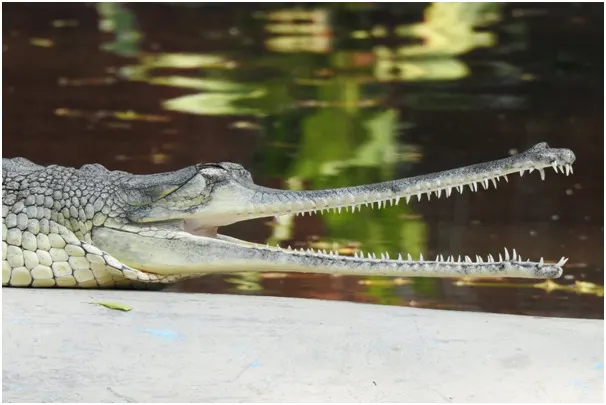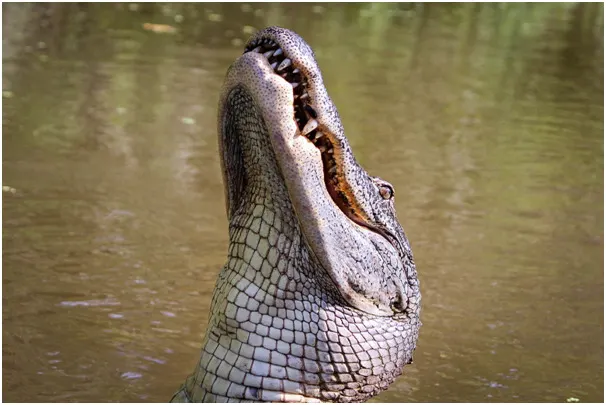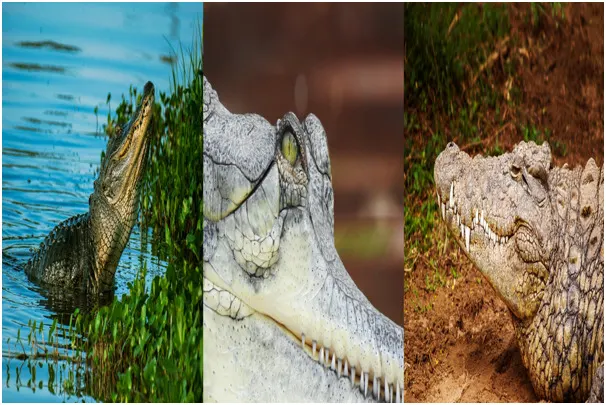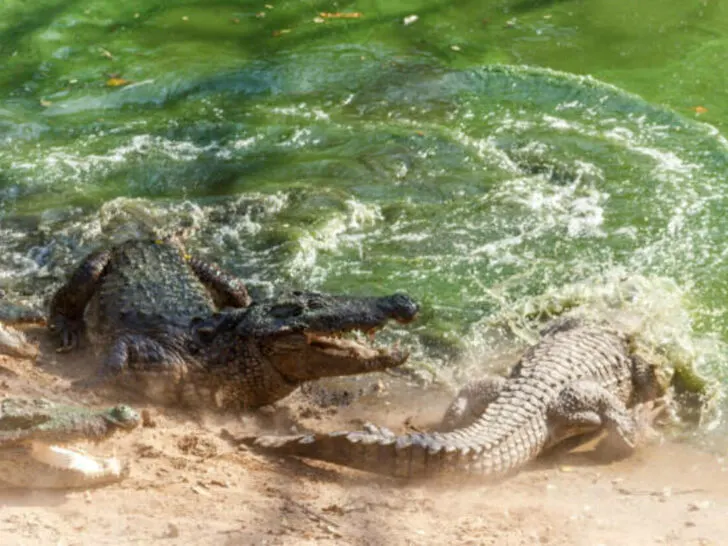Giant reptiles like gharials, crocodiles, and alligators are intriguing creatures. These are carnivores that are capable of attacking people. Despite being aquatic creatures, they may also live on land. They have specific sensory organs that make them aware of various situations.
Though they share many physical characteristics but also exhibit clear distinctions, they all belong to the clan Reptilia and order Crocodilia despite coming from several families. More resemblances exist between the alligator and crocodile than the gharial, which differentiates due to an extended snout.
One of the most noticeable differences between them is their colors. Gharials have olive color, alligators are black and grey, and crocodiles are olive and tan in color.
The entire planet is home to these enormous reptiles. Alligators reside in Asia and North America, whereas crocodiles are found in Africa, Asia, Australia, and North America. Gharials are only found in India and its neighboring nations.
They are dangerous species, and you must take the necessary care before entering their habitat. I had explicitly seen crocodiles when I was in school. I was amazed by their skin texture.
Therefore, I have decided to share the distinction between these species in this article.
Interesting Facts About Gharials
The word “Gharial” has been derived from the word “Ghara,” which Indians use for pots having a bulbous bump near the tip of their snout. The gharial is a morphologic crocodilian, the dominant creature among all surviving crocodiles.

The scientific name of this species is “Gavialis gangeticus.” The length of females is 2.6-4.5 m, whereas the males are 3-6 m. Thanks to their highly attenuated snout, rows of uniformly sharp teeth, and comparatively long, well-muscled neck, they are very effective fish catchers, referred to as fish-eating crocodiles. The weight of gharials is around 150–250 kg.
These reptiles most likely evolved from the northern side of the subcontinent of India. Their fossilized bones were discovered in the Sivalik Mountains’ Pliocene strata and the Narmada River Valley.
They are entirely marine crocodilians; they emerge only from the water to bask and construct eggs on wet sandbanks. They are currently seen living in rivers in the lowlands of the northern Indian subcontinent.
What Makes Alligators Different?
The alligator is the next giant reptile animal in this class. Alligators evolved approximately 53 to 65 million years ago.
They are divided into American and Chinese alligators. The United States’southeastern region is home to the larger of the two kinds.
The name “alligator” is likely an anglicized version of the term “el Lagarto,” a Spanish word for lizard. The alligator was known to early Spanish explorers and residents in Florida.

Alligators have potent tails that they employ during swimming and defense. Whenever they float on the surface, their eyes, ears, and nose are situated on the top of their long heads and stick out into the water just a little.
They have a broad U-shaped snout and an overbite, which indicates that the teeth in the lower jaw are lingual to those in the upper jaw. A large fourth tooth on either side of the lower jaw of the alligator fits into a hole in the upper jaw.
The lower teeth are usually hidden when their mouth is closed. They are carnivores and inhabit the margins of permanent bodies of water like lakes, marshes, and rivers.
Speaking of big reptiles, check out my other article on the differences between Brachiosaurus and Diplodocus.
Some Facts About Crocodiles
Crocodylia is an order of reptiles that includes aquatic creatures with lizard-like appearances and carnivorous diets. The closest surviving relative of birds, crocodiles, is a live link to the dino reptiles of prehistoric periods.

Crocodiles have tiny legs, clawed webbed toes, strong jaws, and numerous conical teeth. They possess a unique body structure in which the eyes and the nostril are above the water surface, while the remaining body is hidden under an aquatic region.
The skin of this animal is thick, rough, and plated, and the tail is lengthy and huge. Numerous crocodilian fossils from the Late Triassic Epoch were found 200 million years ago.
There may have been three significant radiations, according to fossil data. Only one of the four crocodile suborders has persisted up to the present.
Differences Between Gharial, Alligator, and Crocodile

After getting knowledge of these species, let’s discuss their differences.
| Features | Gharials | Alligators | Crocodiles |
| Family name | Gavialdae | Alligatoridae | Crocodylidae |
| Color of the body | Possess olive color | Possess black and grey color | Possess olive and tan color |
| Habitat | Live in freshwater | Live in freshwater | Live in saltwater |
| The shape of the snout | The snout’s long, narrow, and noticeable boss | Broad and u-shaped snout | Angular and V-shaped snout |
| Salt glands | The salt glands are present | They don’t have salt glands | Active in areas with high salinity |
| Moods and behavior | They are shy | They are less aggressive | They are highly aggressive |
| Teeth and jaws | They have sharp teeth | Lower jaw teeth are hidden while the mouth is closed. | Teeth on lower jaw visible with mouth closed |
| Movement Speed | The speed is 15 mph | The pace is 30 mph | The rate is 20 mph |
| Length of body | They are 15 ft long | They are up to 14 ft long | They are up to 17 ft long |
| Weight of the body | They are up to 2000 lbs | They are around 1000 lbs | They are over 2200 lbs |
| Biting force | It’s about 2006 psi | It’s almost 2900 psi | It’s nearly 3500 psi |
| Life span | They live for up to 50-60 years | They live for up to 50 years | They live for up to 70 years |
| Total number of species | Up to 2 | Around 8 | Around 13 |
Other Disparities
The sensory pits of alligators and crocodiles on the lower and upper jaws help them find and catch prey by detecting changes in water pressure. The gharials and alligators have these sensors in the jaw region, while crocodiles possess them all over their bodies.
Crocodiles are found throughout the Americas, Southeast Asia, Australia, and Africa, whereas alligators are indigenous to Eastern China and the Southeastern United States. There are only gharials on the Indian subcontinent.
Crocodiles and gharials can stay longer in the open ocean because their salt glands also increase their tolerance to saline water. Alligators do spend a brief time in salty environments, but they love to live in freshwater areas.
Sounds Produced by Gharials, Alligators, and Crocodiles
- These species do produce sound. Since they can make various sounds, crocodiles and alligators are likely the most vocal reptiles, depending on their circumstances.
- When hatching is about to emerge, they produce chirping sounds, which prompt the mother to dig out of the nest and carry her young outside. They also make such noises as a distress signal when in danger.
- The vast reptiles will hiss loudly, typically used as a frightening call to drive away competitors and intruders.
- These reptiles produce a loud bellowing sound during the mating season. It is a signal of their need to establish privacy.
- The noisiest animals are alligators, although some crocodile species are virtually silent. Both sexes of gharials hiss, and the development of the males’ nostrils causes them to create an odd buzzing sound.
Giant Reptiles: Can They Be Tamed?
It’s unusual to tame these animals as they are dangerous carnivore species.
Sometimes they live in the water so quietly that they don’t make people aware of their presence. These species, hunted by their skin, are great human killers.
However, if a person behaves sensibly and responsibly while in their habitat, they are unlikely to die at the hands of these reptiles. Therefore, necessary care must be taken when feeding them or entering their space.
These creatures may announce their presence by plunging into a swimming pool or devouring a family pet when humans get closer to their habitat.

Are These Species Conserved?
These giant reptiles are “critically endangered” or “endangered.”
Almost one-third of the 23 crocodilian species got this tag. The word “critically endangered” is used for those with an exceedingly significant chance of extinction in the wild, whereas the term “endangered” faces a very high risk of death.
The other 16 kinds are flourishing, thanks to countless conservation initiatives and anti-hunting laws that have kept them from going extinct.
The skin of these species is better conserved. However, those who survive are better cared for by the people who have the duty to feed them.
Final Words
- Giant reptiles like the alligator, crocodile, and gharial are fascinating animals. These animals are carnivores that can attack humans. They are aquatic species, although they can also exist on land.
- Although they come from different families, they all belong to the clan Reptilia and the order Crocodilia despite having many physical similarities and significant differences.
- Basically, their colors are among the most obvious distinctions between them. Alligators are black and grey, crocodiles are olive and tan, and gharials are olive in color.
- Crocodiles live in Africa, Asia, Australia, and North America, whereas alligators live in North America and Asia. Only the countries that border India contains gharials.
- These enormous reptiles are “endangered” or “critically endangered.” However, those responsible for feeding the survivors take better care of them.

